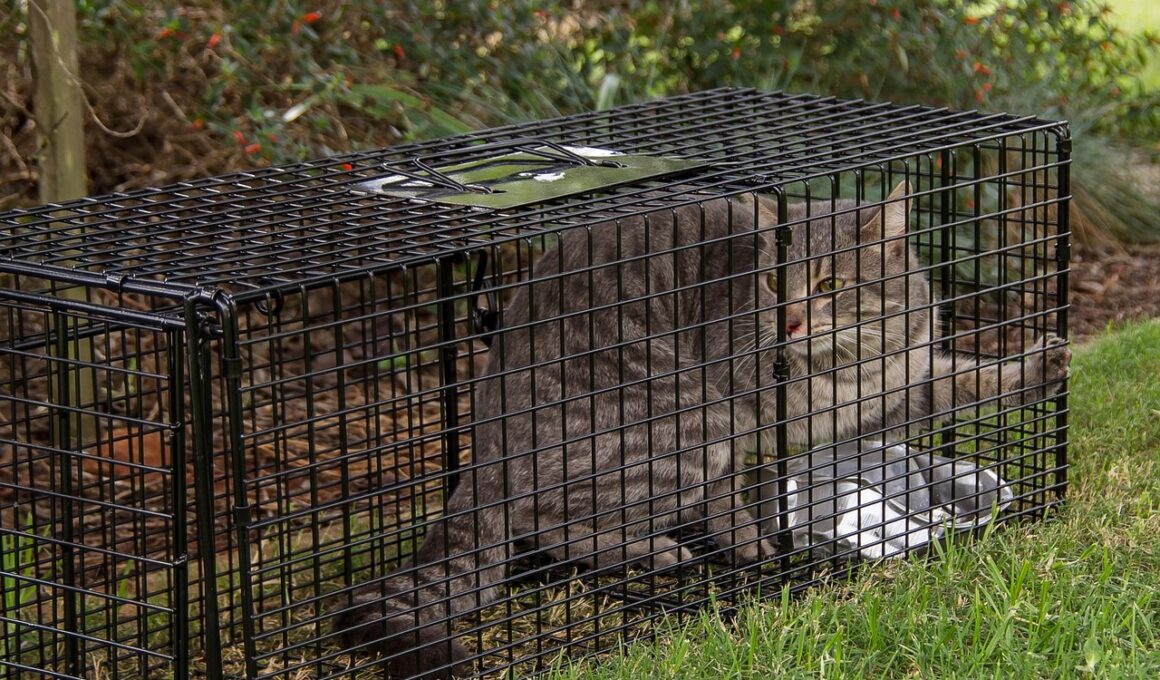Trap-Neuter-Return (TNR) and Animal Control Policies
Trap-Neuter-Return (TNR) is an essential method employed for managing feral cat populations through humane interventions. This approach encourages the capture of feral cats, which are then brought to a vet for spaying or neutering. After the procedure, these cats are returned to their original habitat, leading to a stable population and reduced future litters. Many municipalities are beginning to acknowledge TNR as an effective solution within animal control ordinances. TNR not only helps to mitigate overpopulation but can also improve the health of local feral cat colonies. Moreover, communities can benefit economically because TNR reduces the costs associated with euthanasia and other control methods. However, the implementation of TNR policies often necessitates collaboration between local governments, animal welfare organizations, and residents. Education about responsible pet ownership is vital, as the process can be misunderstood. Understanding the TNR program can lead to more humane and effective animal control policy development. The goal should be to ensure that no animal suffers unnecessarily while respecting the needs of the local community. It promotes coexistence, which is paramount in a multifaceted approach to cat population management.
The effectiveness of TNR initiatives can often challenge existing animal control ordinances, particularly those emphasizing eradication. Local laws may not initially support TNR as viable due to preconceived notions about feral cats. Therefore, it becomes crucial to educate community members and lawmakers about the benefits associated with TNR. Studies suggest that areas implementing TNR report lower cat populations and improved community attitudes toward the homeless cat population. Moreover, communities that embrace such practices frequently witness decreased risks of disease transmission, as spayed or neutered cats are less territorial. Despite these advantages, some regions still debate the necessity of such alterations to their animal control policies. Local governments may fear opposition from residents who do not understand the program’s goals or successes. To foster support, it is essential to provide concrete evidence of TNR’s advantages through studies and case examples. With time, many municipalities have become pioneers in the humane treatment of feral cats, leading to not only healthier cat populations but also an improved environment for humans and pets alike. Advocating for policy changes that embrace TNR can also play a pivotal role in fostering community trust.
The Role of Advocacy in Policy Change
Advocacy plays a crucial role in transforming animal control ordinances to reflect more compassionate approaches like TNR. Many successful campaigns are spearheaded by local animal welfare organizations. These advocates educate the public and decision-makers about the effectiveness of TNR. They provide data driven evidence demonstrating the successful reduction of feral cat populations. Grassroots campaigns often deploy flyers, host informative meetings, and utilize social media to increase awareness. Increased visibility brings communities together for better cat welfare. When citizens are informed of the benefits of TNR, they are more likely to support changes in local laws. Policy changes often encounter resistance from those concerned about diseases or disruptions caused by cats. Thus, presenting factual information and compelling arguments can shift public perception significantly. Involving local veterinarians and animal control officers can lend additional credibility to the cause. Personal stories from residents who have witnessed TNR’s positive effects also make a significant impact. By mobilizing community support and creating a narrative that resonates, advocates can successfully influence local governments to adopt TNR-friendly ordinances. The collaboration of various stakeholders is vital for the effectiveness of these initiatives.
Sometimes, obstacles arise as local governments may hesitate to change existing animal control policies. Budgetary constraints often hinder communities from embracing new programs like TNR. These communities may fear increased operational costs associated with such initiatives. However, supporters emphasize that TNR leads to long-term savings by reducing the need for euthanasia and lower stray animal intake numbers. Moreover, local economies can thrive by attracting tourism when communities engage in responsible cat population management. The combined support of veterinarians, local residents, and animal groups can help alleviate concerns while presenting a compelling economic case. Data from areas with implemented TNR policies often highlight the reduced burden on animal shelters. These shelters can redirect resources towards promoting adoption and fostering responsible pet ownership. Demonstrating that humane treatment is also cost-effective can be a game changer for policy-makers. Continued engagement with local governments can assist in the smooth introduction of revised ordinances. Organizations should work collaboratively with officials to develop funding strategies specifically aimed at TNR initiatives. By debunking myths about funding issues and proving TNR’s sustainability, communities can pave the way for widespread acceptance of progressive animal control practices.
Community Involvement in TNR Programs
Community participation is fundamental for the success of TNR programs. Feral cat populations often thrive in areas where people are sympathetic towards their plight. Engaging the community in TNR helps foster a culture of compassion and responsibility. Volunteers can play an active role in trapping cats, transporting them to clinics, and caring for them during the recovery period. These volunteers create a long-lasting bond between community members and the feral cats they help. To ensure the program’s sustainability, it’s essential to establish community networks. Educational workshops can mobilize volunteers and encourage people to safely and humanely participate. Additionally, sharing details about TNR with neighbors can mitigate conflicts. Public events showcasing TNR success stories can attract more participants and support. Such gatherings allow residents to discuss their concerns, share experiences, and learn how they can make a difference. Schools can also participate by involving children in community service projects related to TNR. Through partnerships with local organizations, students can learn about animal welfare while taking an active role in their community. Their involvement not only fosters empathy but can also shape their future relationship with animals significantly.
Ultimately, the long-term sustainability of TNR programs hinges on education and collaboration. Regular workshops, webinars, and outreach programs ensure that community members remain informed and engaged. Sharing success stories could further inspire others to get involved in advocacy efforts, creating a ripple effect. Comprehensive education on responsible pet care is crucial. Furthermore, providing resources about local ordinances related to animals helps community members understand their rights and responsibilities. Additionally, local governments should actively promote TNR by incorporating it within their public health initiatives. Informing local residents about how TNR affects public health can improve the situation for both people and cats. Educational materials could be disseminated through libraries, schools, and community centers. This would provide a widespread anchoring point for discussions on feral cats in the area. Furthermore, success stories documented in local newsletters, social media, or community boards can keep the momentum going. When residents become stakeholders in TNR efforts, they can influence further policy changes. This grassroots movement fosters compassion while reducing the feral cat population without resorting to euthanasia, benefitting both the animals and the community.
Implementing Effective Animal Control Policies
Implementing effective animal control policies requires collaboration from all facets of society. Policymakers must align with animal welfare groups to craft ordinances that support TNR methods. Continuous dialogue among stakeholders can create transparency and trust while highlighting the importance of community input. Policymakers should also familiarize themselves with successful case studies from other communities already implementing TNR. Local governments can visit regions that have successfully transformed their policies, gaining insight into best practices. When drafting new amendments, officials must ensure that ordinances include key components. These should include provisions for funding TNR initiatives, establishing safety protocols for trapping cats, and identifying specific responsibilities related to each party involved. Engaging with residents during the amendment process builds a sense of ownership for the ordinances. Public hearings can provide essential platforms for voicing concerns and suggestions. Once policies are implemented, communities must remain vigilant to adapt them as community needs evolve. By monitoring the effectiveness of TNR programs, stakeholders can identify areas for improvement. Adjustments may be necessary to keep pace with community dynamics. Continued education for all parties involved ensures the successful and sustainable management of feral cat populations.
In conclusion, Trap-Neuter-Return (TNR) is not merely a method for managing feral cat populations but is also a pathway towards transformative animal control policies. The collaborative effort between local governments, community advocates, and residents is essential for successful TNR implementation. As communities educate themselves about the disparity between traditional and humane approaches, the importance of TNR becomes apparent. Establishing solid support networks strengthens community resolve and lays the groundwork for population control. As we continue to engage with local policymakers and residents, it is crucial to advocate for ordinances that recognize the role of TNR. These policies will lead to healthier cats, less strain on shelters, and a more educated public. In fostering ongoing discussions about feral cats, communities can face challenges with confidence and compassion. Ultimately, embracing TNR leads to better outcomes for both humans and animals. The journey towards effective animal control policies can be complex, but the rewards are invaluable for society. Encouraging empathy while managing feral cat populations improves the human-animal bond and dignifies the lives of all animals involved.


